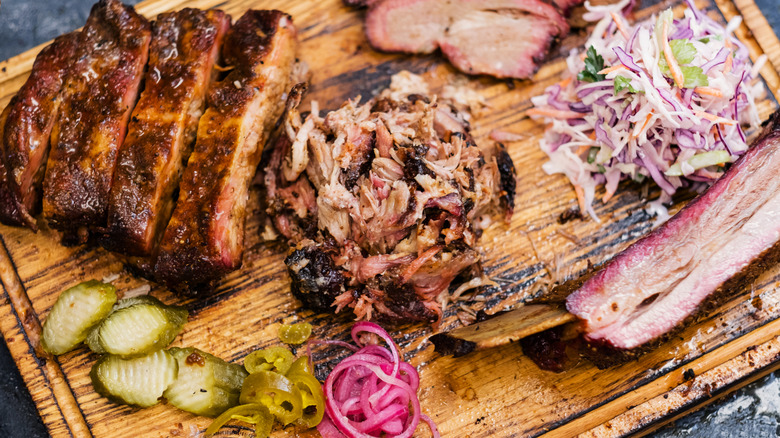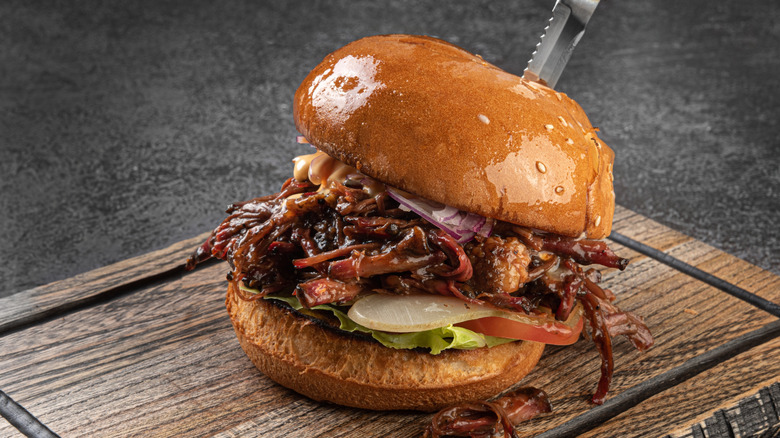This Is What Makes Brisket And Pulled Pork Different
No matter what style of American barbecue you're cooking, no spread is complete without juicy brisket or tender pulled pork somewhere in the mix. At first glance, these staples might seem pretty similar. Both are tough cuts that require low-and-slow cooking to break down dense connective tissue. This long cooking process transforms them into flavorful, melt-in-your-mouth delicacies, commonly served piled high in sandwiches or plated alongside other barbecue classics like creamy coleslaw, thinly sliced pickles, or smoky baked beans. So what makes them different? To find out, Food Republic consulted BBQ expert Christopher Prieto, a 2025 James Beard Foundation nominee for "Best Chef Southeast," champion pitmaster, and owner of Prime Barbecue. Prieto revealed that the differences go beyond just the fact they're cuts from different animals — they're also rooted in how they're smoked, seasoned, and how their fat and connective tissue transform during cooking.
"Cooking a brisket is going to be long and hard," Prieto told us. "The key is to get both muscles to break down at the same time while maintaining the integrity and moisture of the meat. Like most beef, the seasoning process needs to be simple and clean to allow the flavors to show." This contrasts with the approach taken when cooking pulled pork, which involves complex, sugar-based seasoning rubs, a sweeter blend of smoking woods, and is a comparatively more forgiving and easier-to-work-with cut of meat.
Brisket's structure and its smoking essentials
Brisket is known for its dense connective tissue and high collagen content — more so than pork shoulder, which also contains collagen but yields a softer, stringier texture. What sets brisket apart is how the collagen transforms during cooking. Christopher Prieto explains: "Collagen breaks down during the long cooking process and transforms into delicious gelatin." This, combined with low cooking temperatures, "tenderizes this tough cut of meat into a butter rich flavor," he told us.
Brisket consists of two primary muscles: the deckle (thicker and marbled) and the flat (leaner). "The key is to get both muscles to break down at the same time while maintaining the integrity and moisture of the meat," Prieto said. This dual-muscle structure makes brisket challenging to perfect, as each part cooks at different rates. Achieving uniform tenderness requires a degree of experience and skill. This makes choosing the best smoking wood for brisket especially important. Prieto recommends: "[Maintain] a consistent fire for the entire cook ... I always use oak in my cooking process." Compared to the milder smoking woods used in pulled pork, oak delivers strong, even burning.
As for seasoning, simplicity is key. "Like most beef, the seasoning process needs to be simple and clean," Prieto recommends — so avoid strong rubs that distract from the beef's natural flavor. Instead, he recommends a straightforward salt and pepper seasoning (50/50), as it encourages the smoke to bond with the pepper and the salt to assist the fat in creating a rich, flavorful bark.
The secrets to perfectly smoked pulled pork
Pulled pork generally comes from pork shoulder or pork butt. While pork butt has more intramuscular fat, both cuts have "lots of connective tissue and [contain] both light and dark meat," Christopher Prieto told us. This combination of lighter, leaner muscle fibers with darker, fattier, and more collagen-rich meat sets pulled pork apart from brisket, which is composed mostly of dark muscle. Considering this delicate balance of flavors, Prieto recommends: "Cook this protein for a long period of time [8 to 12 hrs] in the range of [250 to 275 degrees Fahrenheit]." While the low-and-slow method still applies, pulled pork cooks for less time than brisket, which helps it preserve its natural tenderness and moisture.
When it comes to smoking wood, Prieto suggests a more aromatic approach: "For this cut I prefer to use a blend of 75% pecan and 25% cherry wood." Unlike the robust, strong-burning oak used for brisket, the combination of these woods "helps give the pork meat a nutty and sweet flavor," he told us.
Pulled pork also welcomes more complex flavor profiles. "Sugar is a must with this cut of meat," Prieto explained. "[It] helps balance the richness of the protein to give the end result a sweeter bark." Massaging on light brown sugar mixed with salt, spices, and herbs before smoking can help develop a sweet, caramelized bark during cooking. Once shredded, it also pairs beautifully with a sweet Texas-style barbecue sauce, adding a robust depth and balance to every bite.



